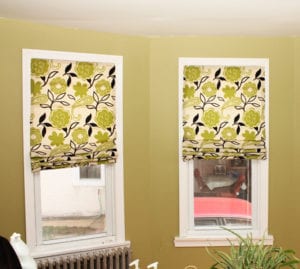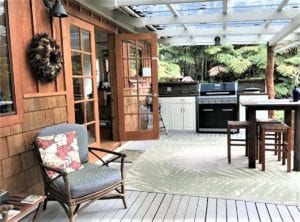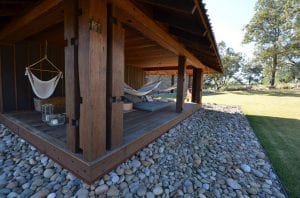Last Updated on May 22, 2024 by teamobn
The use of triangles is one of the fundamental principles of bamboo construction. This stable and rigid shape is commonly used in most bamboo constructions for stability and rigidity. By utilizing the strong and sturdy properties of bamboo, builders are able to create buildings and other structures that are both reliable and beautiful.
We decided to challenge the notion of using triangulation for structural stability in every project. By exploring new designs and connections, we were able to create a more stable structure that didn’t rely on triangulation. This allowed us to create a more efficient and effective design that saved time and money.
Bamboo Construction Project
This bamboo construction project was to build a bamboo pergola as an outdoor semi-open space. The pergola would be used to support creepers and vines, providing shade during the summer months. The structure was to be made entirely of bamboo, using traditional joinery techniques. This structure was built during a Bamboo Construction Workshop we conducted in Sydney.
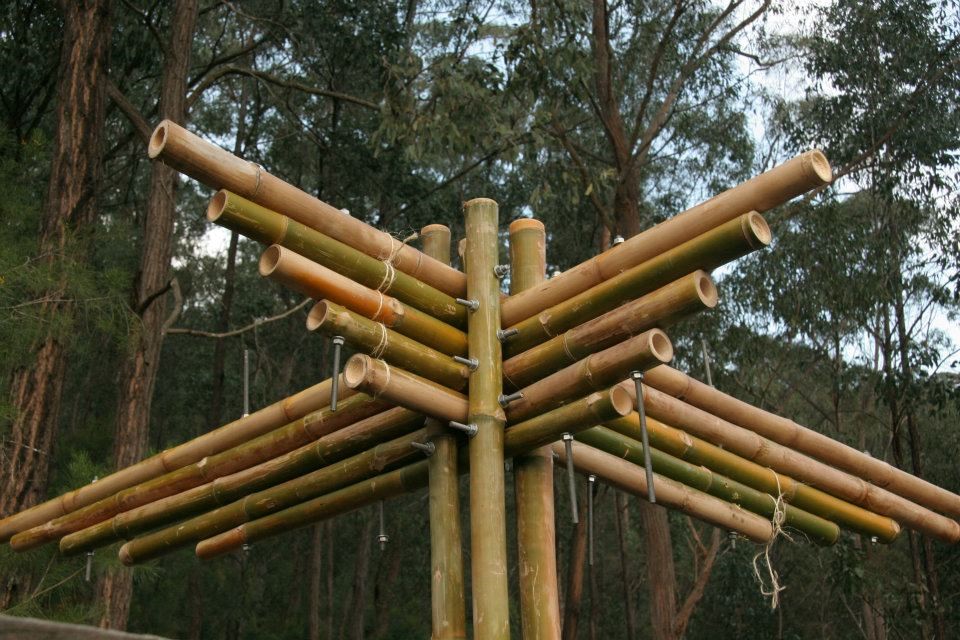
The design of the structure is inspired by the surrounding landscape and the existing house which is very Japanese in character. The structure has a square plan with four columns on its four corners. Each column is made of four bamboo poles and the beams are made of corbelled bamboo members which reduce in its length consecutively. Each corbelled bamboo beam member is bolted to the column which helps achieve a rigid frame.
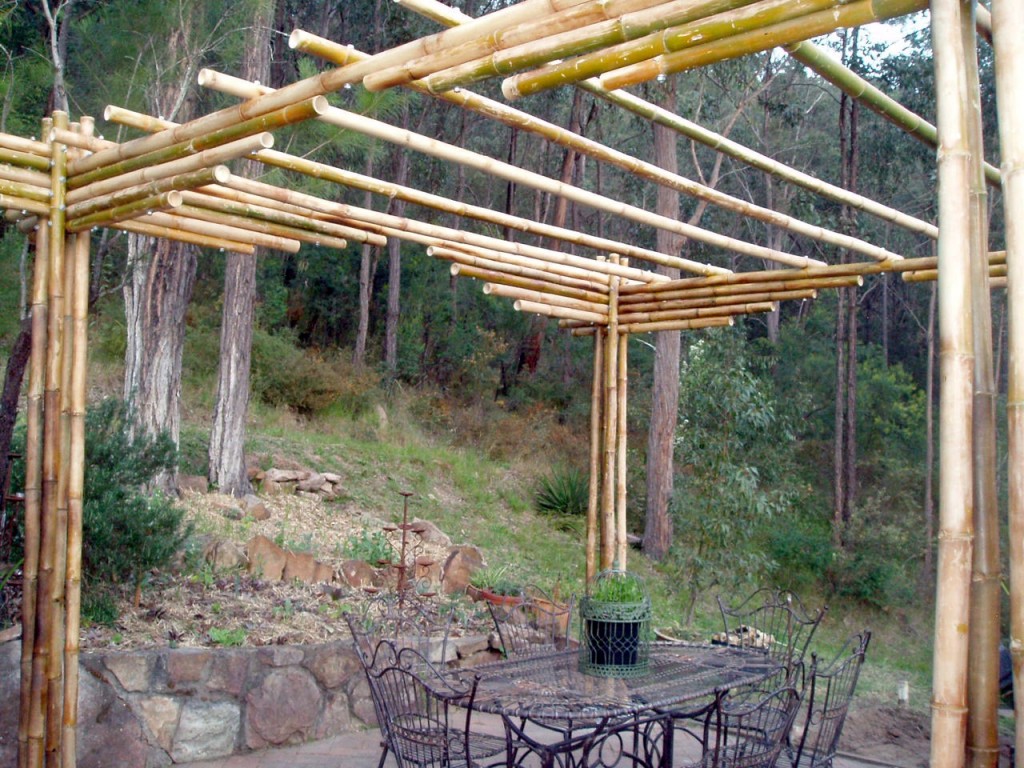
We had used this design principle earlier in the very first bamboo structure we designed and built in India. In that design, the corbels were 2 dimensional and hence we did not get sufficient lateral stability. In the current design, the corbels are cross-connected i.e. 3-dimensional and hence the structure is very stable. The pergolas on the top add to the overall rigidity and provide support for the vines.
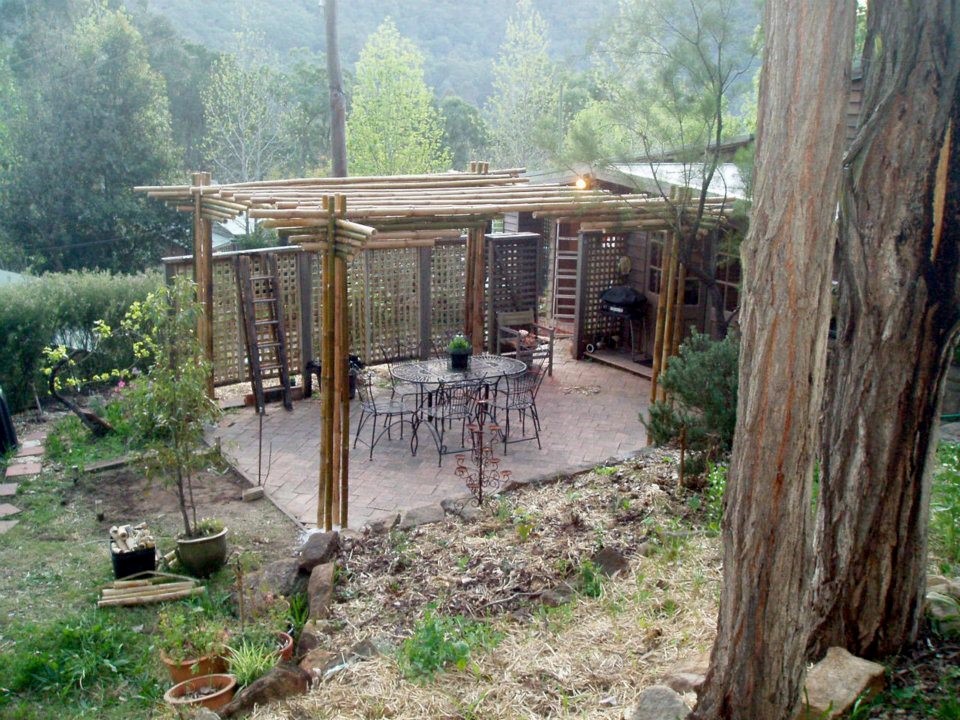
For the participants, it was a good exercise in understanding the subtle variations in bamboo sizes though they belong to the same species, as bamboo is a non-industrialized natural material. The participants learnt about various bamboo species, treatments and construction principles. They also learnt that a little bit of flexibility and innovation is required in the design and when building with bamboo as is the case with most natural materials.
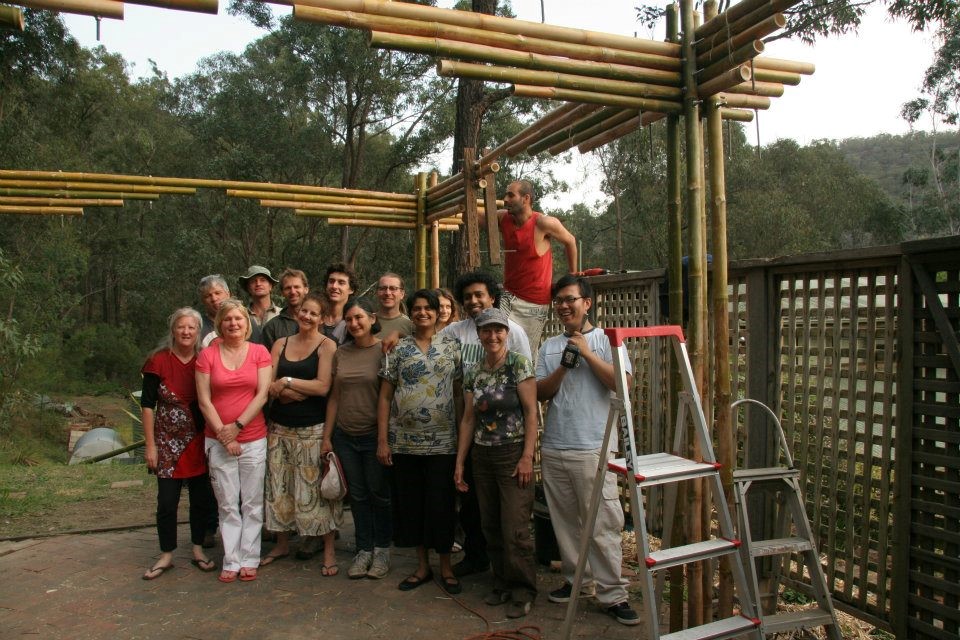
It’s very satisfying to be able to finish a bamboo construction workshop project within a weekend as the tired but happy faces show 🙂
Overall it was a challenging exercise that resulted in a very satisfactory outcome. I am sure that we will be using this design principle again in other structures to come as the possibilities with bamboo construction design are endless.
Sustainability Benefits of Bamboo Construction
Bamboo is becoming an increasingly popular material in sustainable building practices. Its remarkable growth rate and ability to regenerate quickly make it an environmentally friendly alternative to traditional construction materials. Here’s how incorporating bamboo into building projects can contribute to a greener future.
Rapid Renewability
Bamboo sets a remarkable standard for rapid renewability in the plant kingdom. Some species are known to grow up to 35 inches in just 24 hours under optimal conditions. This phenomenal growth rate is significantly faster than that of hardwood trees, which can take 20 to 50 years to reach maturity.
Bamboo’s ability to mature quickly means it can be harvested frequently without the risk of environmental depletion. In fact, a single bamboo clump can produce up to 15 kilometers of usable pole in its lifetime.
Harvesting bamboo every three to five years doesn’t harm the plant system; rather, it encourages new growth, making bamboo a continuously renewable resource. This frequent harvest cycle ensures a steady supply of building material that does not contribute to deforestation, unlike traditional wood sources.
Carbon Sequestration
One important aspect of bamboo’s environmental preservation contribution is carbon sequestration. Bamboo forests absorb carbon dioxide from the atmosphere quite well because of their rapid reproduction and dense growth.
Research indicates that, compared to many other tree species, bamboo can store up to 12 tonnes of carbon dioxide per hectare yearly. As such, bamboo becomes a powerful partner in the battle against climate change.
Building with bamboo not only takes use of its robustness and adaptability as a material but also helps to lower the carbon impact that comes with building projects. Including bamboo into building designs allows architects and builders to produce environmentally friendly and creative buildings. Bamboo is a great option for environmentally friendly building projects because of its dual ability to fulfill structural and environmental functions.
Low Energy Consumption
The low energy needs of bamboo construction contrast sharply with the energy-intensive production of conventional building materials like steel or concrete. Bamboo is naturally strong, therefore it can be used successfully in both its natural and little processed forms.
This feature greatly lowers the requirement for sophisticated technology and high energy consumption in processing in bamboo construction. Therefore reducing the use of fossil fuels and the greenhouse gas emissions that go along with them.
Furthermore supporting bamboo’s eco-friendly reputation is its lightweight character, which lowers energy and transportation expenses. Bamboo is a strong contender for sustainable building programs since it helps construction projects lessen their total environmental effect.
Biodegradability
Complete biodegradability of bamboo construction is among its most convincing environmental benefits. Bamboo products can be organically broken down by microorganisms and then returned to the land as compost. This procedure prevents the environmental damage linked to non-biodegradable garbage in landfills and adds to the nutrient cycle.
Bamboo breaks down without releasing poisonous chemicals into the environment, unlike plastics and other manmade materials which stay in the ecosystem for hundreds of years and add to pollution and toxicity. This feature of bamboo helps with sustainable material management in building projects and also lowers waste.
Soil Protection
Soil integrity is benefited by the growth of bamboo. The soil structure benefits when the bamboo roots are left whole even after harvesting. Through their ability to bond the soil, these roots stop erosion and topsoil loss during intense rains and flooding.
The bamboo root system also encourages water absorption and retention, which improves soil fertility and creates a healthier environment for other plants to flourish. Because of its specific value in regions vulnerable to erosion and soil deterioration, bamboo is a crucial crop for environmental restoration initiatives.
The capacity of the root system to preserve soil quality encourages environmentally friendly farming methods around bamboo plantations, therefore enhancing the sustainability and ecological balance of rural areas.
Incorporating bamboo into building designs like a grass cubby not only supports environmental sustainability but also promotes economic development in regions where bamboo is cultivated. Its use in construction projects underscores a commitment to eco-friendly building practices and a healthier planet.
Bamboo Treatment and Maintenance
Bamboo is renowned for its durability and strength, making it an ideal material for construction. However, like all natural materials, it requires proper treatment and maintenance to ensure it remains in optimal condition throughout its use.
Here’s a guide to effectively treating and maintaining bamboo construction projects.
Treatment Before Use
Bamboo must be treated in particular ways to increase its durability and resistance to environmental influences before it can be used in building. These treatments prevent decay, insect infestation, and fungal growth—all frequent problems with natural materials.
One well—used technique is boron treatment, a non-toxic preservative that shields bamboo against deterioration and insects. In building with bamboo, this stage is essential to guarantee the material’s durability and structural soundness.
Regular Maintenance
Once included into a building project, bamboo needs to be routinely maintained to remain in good shape. Periodically looking for wear or damage, such cracks, splits, or discolouration, is part of this.
In order to maintain the natural color and shield bamboo from moisture, it is crucial to apply natural oil or a sealer designed especially for bamboo every few years. Regular upkeep of bamboo buildings extends their lifespan and guarantees their beauty and usefulness for many years to come.
Protecting Bamboo from Moisture
Bamboo in building is mostly threatened by moisture. Making ensuring that bamboo components in building are properly sealed and kept dry is crucial to avoiding damage from moisture.
Particular waterproofing precautions could be required in locations that are likely to experience excessive humidity or come into direct touch with water. To prevent water retention, which could cause structural flaws, bamboo construction also needs to take ventilation and drainage into account.
Pest Control
Insect infestation can significantly compromise the integrity of bamboo in construction. Regular inspections are crucial to detect any signs of infestation early. Treatment options include applying borate solutions or other eco-friendly insect repellents that are safe for bamboo constructions. Ensuring that bamboo does not come into direct contact with the ground or keeping it away from untreated wood can also help prevent insect-related issues in bamboo constructions.
By following these guidelines for treatment and maintenance, bamboo constructions can achieve maximum durability and aesthetic appeal. Proper care ensures that bamboo remains a sustainable and reliable choice in modern building practices, contributing to eco-friendly construction initiatives worldwide.
About Munir Vahanvati:

Munir is an architect and urban designer with more than 12 years of industry experience. He has been involved in working with bamboo for the last 10 years. He is passionate about designing and using the natural form of bamboo to create rhythmic structures that create a play of light and shade. In Nov 2013 Munir took on the role of Vice-President at the Bamboo Society of Australia.
About Giant Grass:
Giant Grass is a social enterprise focused on sustainability and hands-on learning through bamboo. In addition to designing and building structures out of bamboo, we regularly conduct Bamboo Construction Workshops in Melbourne and across Australia. For more information on our projects and workshops please visit us at www.giantgrassdesign.com

